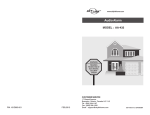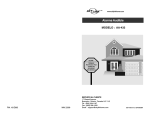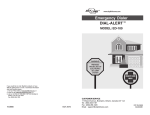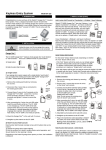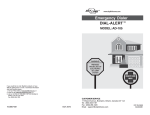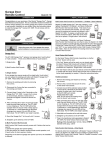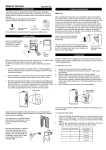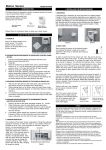Download SkyLink SC-10 User's Manual
Transcript
www.skylinkhome.com Total Protection Alarm System MODEL: SC-10 CUSTOMER SERVICE 101A073-001 AUG, 2005. 17 Sheard Avenue, Brampton, Ontario, Canada L6Y 1J3 Tel : (800) 304-1187 Fax : (800) 286-1320 Email : [email protected] PAT. 6243000B1 SKYLINK TECHNOLOGIES INC. Your Guide to the Total Protection Alarm System MODEL: SC-10 ADDITIONAL ACCESSORIES Smoke Sensor (SS-433) - Detects sound frequencies of existing smoke, carbon monoxide alarms - Activates Security Control Panel (SC-001) or Emergency Dialer (AD-433S) when the preset sound frequency is detected - 9V alkaline battery included Audio Sensor (AS-433) - Detects alarm sound from existing security system alarm; sends signal to Dial-Alert. - Eliminates need for monitoring service. - 9V alkaline battery included Temperature Sensor (TS-434) - Monitors temperature of a specific area (i.e., greenhouse, horse farms, laboratory etc.) - Activates Security Control Panel (SC-001) or Emergency Dialer (AD-433S) when the temperature of the monitored area is above or below a preset temperature - Temperature range: 0°F (-19°C) to 159°F (69°C) - Operates using lithium batteries (included) Flood Sensor (FS-433) - Place sensor along basement wall, near water heater, washing machine etc. - Notifies Security Control Panel (SC-001) or Emergency Dialer (AD-433S) when water is detected - 12V alkaline battery included –2– –19– ADDITIONAL ACCESSORIES Security Control Panel (SC-001) - Four alarm modes (Day, Night, Away, Chime) - Four zones, each zone controls up to 6 devices - Reliable design with microcontroller - 110dB siren Silent Alarm (SW-433) - Plugs into any AC outlet, then plug light into Silent Alarm unit - Light flashes when sensor(s)/transmitter(s) is (are) activated - Silently alerts occupants including the hearing impaired Vibration Sensor (VS-433) - Activates Emergency Dialer when vibration is detected - attach vibration sensor to valuables, (stereo system, antiques) - 9V alkaline battery included Water Resistant Panic Button Transmitter (PT-434) - Activates Security Control Panel and Emergency Dialer by pressing the panic button when under duress - Ideal for Seniors, Handicapped and Disabled - Water resistant, carry transmitter all the time - Operates using lithium batteries (included) TABLE OF CONTENTS PACKAGE CONTENTS....................................................................... 4 OVERVIEW........................................................................................ 5 PLANNING YOUR HOME SECURITY NEEDS.......................................6 INSTALLATION Audio Alarm........................................................................................7 Door/Window Sensors......................................................................... 8 TESTING YOUR SYSTEM..................................................................10 LIGHTS AND SOUNDS......................................................................11 ACTIVATE/DEACTIVATE SYSTEM......................................................12 PROGRAM SENSORS AND TRANSMITTERS ....................................13 DELETE SENSORS AND TRANSMITTERS.........................................14 BATTERY MAINTENANCE Audio Alarm......................................................................................15 Door/Window Sensor......................................................................... 16 Keychain Transmitter.........................................................................16 ADDITIONAL ACCESSORIES (OPTION)..............................................17 Keypad Control (KP-433) - Functions as an external keypad or secondary control location - Use the keypad to arm/disarm the Audio Alarm (AA-433) - Eliminates the need to walk through your premises to your Security Systems Control Panel - Operates using lithium batteries (included) –18– –3– PACKAGE CONTENTS ADDITIONAL ACCESSORIES All materials required for installation are included in this package: Additional sensors and transmitters as well as add on accessories are available to work with your security system. One Audio Alarm (AA-433) - includes 1 antenna (installed) 1 AC adapter 1 9 volt alkaline battery Motion Sensor (PS-434A) - Monitors area in a 110 degree ARC and up to 40 feet away from the sensor - 9V alkaline battery included Two sets of Door/Window Sensors (WT-433) each set includes: 1 transmitter 1 magnetic switch (attached to the transmitter) 1 magnet 2 spacers 1 12 volt alkaline battery (installed) Door/Window Sensor (WT-433) - Attaches to all doors, windows, entrances - Add on as many magnetic switch (MS-001) as needed - 12V alkaline battery included Two Keychain Transmitters (4B-434) each includes: 1 12 volt alkaline battery (installed) Two packs of screws and anchors (for the Audio Alarm and the Door/Window Sensors) One template (to aid in the installation of the Door/Window Sensors and Audio Alarm) Double Sided Tape (to help in the installation of the Audio Alarm and Door/ Window Sensors) Warning Stickers 2 pcs Manual Warranty Card –4– Magnetic Switch/Magnet (MS-001) - Used in conjunction with Door/Window Sensor (WT-433) - Add on for additional doors, windows Keychain Transmitter (4B-434) - Activates Audio Alarm (AA-433) instantly by pressing panic button - Reliable design, crystal base transmission with microcontroller - 12V alkaline battery included Emergency Dialer (AD-433S) - When the alarm is activated, the Emergency Dialer automatically sends a preprogrammed voice message to as many as nine different phone numbers - If any numbers are busy or there is no answer, the Emergency Dialer will go back and redial each number nine times or until there is an answer - No need to pay monitoring fees - Ideal for home, small business - Operates by AC adapter with battery back up –17– OVERVIEW BATTERY MAINTENANCE DOOR/WINDOW SENSOR BATTERY Each Door/Window Sensor operates on a 12 volt alkaline battery that is inside the transmitter. The sensors come with the batteries already installed. Congratulations. You have just purchased one of the most reliable and upto-date Wireless Security Systems on the market today. Skylink’s innovative rolling code technology provides increased security and trouble free wireless connections. It guarantees that the Audio Alarm will only recognize radio waves from it’s remote sensors, (Door/Window Sensors and the Keychain Transmitter). To replace the Door/Window Sensor batteries: This manual is divided into 6 categories: 1. Push the clip on the bottom of the transmitter case with a sharp object, (such as a paper clip or pen knife) and pull away from backplate. 1. Planning - explains how to plan a security strategy. - recommended locations to install you Door/Window Sensors. 2. Pry out the old battery from one end. - 3. Push the new battery back into place. A diagram beside the battery well indicates which end is positive and which is negative. + 2. Installation and Testing - how to install the Audio Alarm and the Door/Window Sensors. - once everything is installed, explains how to test each device. 4. Snap the transmitter back onto the backplate. 3. Lights and Sounds - explains the functions of all the lights on the Audio Alarm. - describes all the sounds emitted from the Audio Alarm. KEYCHAIN TRANSMITTER BATTERY 4. Activate/Deactivate the System - explains how to activate and deactivate the Audio Alarm. - introduces the Panic Button. The Keychain Transmitter operates on a 12 volt alkaline battery which has been installed at the factory. To replace the Keychain Transmitter battery: 5. Program Sensors and Transmitters to the Audio Alarm - how to program the Door/Window Sensors. - how to program the Keychain Transmitter. 6. Battery Maintenance - explains how to change batteries in all sensors and transmitters. 1. Undo the two screws on the back cover of the transmitter. The back will then come off. 2. Using a small screwdriver or pen knife, pry out the old battery from one end. 3. Place the new battery into position. A diagram beside the battery well indicates which end is positive and which is negative. 4. Close the back cover with the two screws. –16– + –5– PLANNING YOUR HOME SECURITY NEEDS BATTERY MAINTENANCE Before you begin to install your Security System, analyze the premises to determine your security needs. If your premises has two entrances, you may want to put a Door/Window Sensor on each door. You may choose your main door and a window that is hidden by some bushes and is not visable from the street. If you are securing a small business, you may choose the front door and the warehouse door as locations for your sensors. (If your security plan requires additional Door/Window Sensors, or some Motion Sensors, see Additional Accessories at the end of the manual. The SC-10 Security System comes with five batteries that may have to be replaced at some point: Motion Sensors (optional) monitor an area and if there is any movement in that area, the Motion Sensor will send a signal to the Audio Alarm and the alarm will sound. Recommendation: test your system periodically to ensure that all batteries are working. Sketch a map of the premises and determine which doors and windows need sensors and whether you require Motion Sensors. BEDROOM One 9 volt alkaline battery for the Audio Alarm Two 12 volt alkaline batteries for the Door/Window Sensors Two 12 volt alkaline batteries for the Keychain Transmitters AUDIO ALARM BATTERY The Audio Alarm comes equipped with a back up battery in case the electrical power is interrupted for any reason. BACK DOOR DOOR/WINDOW SENSOR BEDROOM When the Audio Alarm battery is low, the “LO BATT” lights goes on. To replace the Audio Alarm backup battery: KITCHEN 1. Take the Audio Alarm off the wall 2. Turn off the unit and remove the AC adapter BATHROOM LIVING ROOM DINING ROOM AUDIO ALARM 3. Remove the six screws then take off the back cover 4. Disconnect old battery MASTER BEDROOM FRONT DOOR DOOR/WINDOW SENSOR The Audio Alarm is water resistant so it can be installed indoors or outdoors within access to an electrical outlet. We recommend that you install the Audio Alarm close to the front door so you can hear when the unit is activated/ deactivated. –6– 5. Connect new battery 6. Replace the back cover and install the six screws The battery life, (9 volt alkaline battery), is approximately two years if only used for backup. –15– DELETE SENSORS AND TRANSMITTERS INSTALLATION You can not delete one sensor/transmitter from the Audio Alarm at a time. You must clear all the sensors and transmitters that are currnetly communicating with the Audio Alarm, then re-program the ones you want to keep. Installation is done using the screws included. For your convenience, we have also included wall anchors and a template to aid in the installation of the Audio Alarm and the Door/Window Sensors. Delete All Sensors and Transmitters 1. Turn the Audio Alarm off by sliding the switch on the bottom of the Audio Alarm so that the “ON” light is not lit. How to use the template to help in the installation: 1. Tape the template to the wall where you would like the component to be 2. Screw part way into the surface where the holes are marked on the template 3. Unscrew the screws and remove the template 4. Screw the component in place where you started the screws We recommend that you install all components first with the double sided tape included and once you are satisfied with the positioning, reinstall using the screws. 2. Press and hold the learn button found on the bottom of the Audio Alarm. INSTALLING THE AUDIO ALARM The Audio Alarm is water resistance so it can be installed indoors or outdoors within access to an electrical outlet. Be careful that the AC adapter wire doesn't guide rain water to the DC JACK located at the bottom of the Audio Alarm. 3. While holding the button, turn on the Audio Alarm by sliding the switch on the bottom. There are two ways to attach the Audio Alarm to the wall: Hanging it on two stationary screws 4. You will hear a long beep followed by a series of short beeps. When you hear the short beeps, release the learn button. 1. Using the template provided, insert the two screws into the wall. You have now cleared all sensors and transmitters from communicating with the Audio Alarm. 2. Align the two top keyholes on the triangular tabs located at the back of the Audio Alarm with the screws on the wall. 3. Gently push the Audio Alarm on to these two screws. 4. Open the small door on the bottom of the Audio Alarm. 5. Insert the AC adapter and the antenna in the appropriate holes. 6. Close the small door so that the AC adapter and the antenna are running through the appropriate spaces in the door. –14– –7– INSTALLATION PROGRAM SENSORS AND TRANSMITTERS TO THE AUDIO ALARM Screwing the unit to the wall 1. Unscrew the two triangular hanging tabs located at the back of the Audio Alarm. The two Door/Window Sensors have been preprogrammed as well as the keychain transmitter at the factory to communicate with the Audio Alarm. If after testing, there is no communication or you have purchased additional Door/ Window Sensors or Motion Sensors, (option), follow the instructions below: 2. Turn them around and slide them back into place so that the two tabs are pointing up and the two keyholes are visible from the front. Note: As many as 15 sensors and keychain transmitters can be programmed to communicate with the Audio Alarm. 3. Position the Audio Alarm on the wall and insert the two screws in the two keyholes. Do not insert the screws all the way into the wall, leave some room on the screw to hang the Audio Alarm. We can also use the template if needed. Program Door/Window Sensors & Keychain Transmitter 1. With only the “ON” light lit on the Audio Alarm, press and hold the learn button located on the bottom of the Audio Alarm. 2. While pressing down on the button, For Door/Window Sensor - press the button on top of the transmitter of the Door/Window Sensor. For Keychain Transmitter - press any of the four buttons on the Keychain Transmitter and hold for 2 seconds. 4. Open the small door on the bottom of the Audio Alarm. 5. Insert the AC adapter and the antenna in the appropriate holes. 3. If a connection has been made, the Audio Alarm will stop beeping and make a continuous tone until the "learn" button on the Audio Alarm is released. 6. Close the small door so that the AC adapter and the antenna are running through the appropriate spaces in the door. 4. Now test the sensor by opening the door or window. If the Audio Alarm beeps, they are communicating. INSTALLING THE DOOR/WINDOW SENSOR (WT-433) Note: If you are alone while programming the sensors, take the Audio Alarm off the wall and bring it to the sensors so all the components are in one place. It is recommended to install one sensor on your front door and the other on your back door. Each contact sensor has 4 parts: Transmitter Magnetic Switch Magnet –8– Spacers –13– ACTIVATE AND DEACTIVATE THE SYSTEM Now that the system is installed and the sensors are communicating with the Audio Alarm, it is time to learn how to arm and disarm the Audio Alarm. The only way to arm and disarm the Audio Alarm is via the Keychain Transmitter and Keypad Control (option). KEYCHAIN TRANSMITTER 4B-434 Turns off the siren and/ or disarms the system #3 Arms the system #1 #2 Activate/deactivate the chime sound made when a sensor is activated and the Audio Alarm is not armed Panic button INSTALLATION 1. Position the transmitter beside the door/window frame on the wall using either two sided tape or screws. If you are using screws, first pry off the back plate with a small screwdriver and screw the back plate into position using the template. Then click the transmitter on to the back plate now mounted on the wall. 2. Position the magnetic switch connected to the transmitter on the door/window frame. 3. Position the magnet on the door beside the magnetic switch. They should be no more than 1 cm (3/8 inch) apart. When the door/ window is closed, the magnets are in contact. When the door/window is opened, contact is broken and the transmitter sends a signal to the Control Panel to activate the chime or alarm. When the Audio Alarm is ON, the four buttons on the transmitter do the following: Panic Button - instantly activates the alarm, whether the Audio Alarm is in arm mode or not. Will always activate the alarm when the “ON” light is lit on the Audio Alarm. Button #1 - this button will arm the Audio Alarm so that the Audio Alarm will communicate with the sensors and transmitters. Button #2 - when the system is on but not armed and a remote sensor is activated, the Audio Alarm will emit one chime, (beep). Button #2 allows you to activate or deactivate the chime sound. For example, if people are using the frontdoor constantly, you may choose to turn off the chime sound. Button #3 -when the siren is sounding, this button will turn off the siren and disarm the Audio Alarm. - when the siren is not sounding but the system is armed, this button will disarm the Audio Alarm. –12– –9– TESTING YOUR SYSTEM LIGHTS AND SOUNDS Before you learn how to use your security system, test to make sure that the Door/Window Sensors and the Keychain Transmitter are communicating with the Audio Alarm. LIGHTS TESTING THE DOOR/WINDOW SENSORS ON light lit Turn on the Audio Alarm, (slide the button on the bottom of the unit to “ON”), allow 30 seconds for the Audio Alarm to warm up. The red “ON” light will appear. (when testing, do not turn the “ARM” light on or the siren will sound.) ALL BELOW SCENARIOS INCLUDE THE “ON” LIGHT LIT 1. Open the door or window that has the sensor on it. 2. The Audio Alarm will beep and the “ON” light will flash once, meaning the Audio Alarm has accepted the signal from the Door/Window Sensor. If the unit didn’t beep, it is not communicating with the sensor. Relocate the Magnet closer to the Magnetic Switch or the Door/ Window Sensor. It may need to be programmed to communicate with the Audio Alarm, (see Program Sensors and Transmitters) 3. Repeat the above 2 steps with the other door or window with the sensor. TESTING THE KEYCHAIN TRANSMITTER Turn on the Audio Alarm so that only the “ON” light appears. Press button 1, 2 or 3 on the Keychain Transmitter, and if the Keychain Transmitter is communicating with the Audio Alarm, the "ON" light will flash once. The "ARM" light will come on if you press button 1.The Audio Alarm may beep once depending if you have the sound turned on. Button 2 activates and deactivates the sound. If the "ON" light does not flash, you must program the Keychain Transmitter to communicate with the Audio Alarm. (See Program Sensors and Transmitters) –10– LO BATT light off LO BATT light on “ARM” light on “ARM” light off -power is being sent to the Audio Alarm. - the Audio Alarm is being powered by electrical current and/or the battery. - the Audio Alarm is being powered by electrical current only, the battery is weak and needs to be replaced. - the Audio Alarm is armed and will sound when any sensor is activated. - the Audio Alarm is not armed and will not sound when any sensor is activated. - it will however respond to both ARM buttons and the PANIC button on the Keychain Transmitter. SOUNDS You are able to turn on/off the short beep sound made by the Audio Alarm when any of the sensors are activated, by pressing button 3 on the Keychain Transmitter. One long beep - occurs when the Audio Alarm is turned on with the button on the bottom of the unit. One short beep - when a sensor is activated and the Audio Alarm is on but not armed. - anytime buttons # 1, 2 or 3 is pressed on the Keychain Transmitter and the Audio Alarm is on but not armed. –11–












